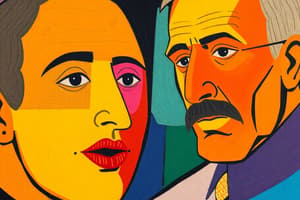Podcast
Questions and Answers
What is a key difference in media effects between social media and television according to recent meta-analysis?
What is a key difference in media effects between social media and television according to recent meta-analysis?
- Television provides more personalized content.
- Television involves more active participation.
- Social media shows a larger effect size for certain demographics. (correct)
- Social media tends to have weaker effects.
Which theory explains how the media shapes our perception and attitudes toward specific topics?
Which theory explains how the media shapes our perception and attitudes toward specific topics?
- Agenda-setting theory (correct)
- Cultivation theory
- Spiral of silence
- Framing theory
In the context of media effects, what does 'frame building' refer to?
In the context of media effects, what does 'frame building' refer to?
- The process of presenting information in a particular way to evoke certain interpretations. (correct)
- The reaction of individuals in echo chambers to outside opinions.
- The incorporation of diverse viewpoints in media narratives.
- The establishment of public opinion through biased reporting.
What are the implications of 'echo chambers' regarding individual media consumption?
What are the implications of 'echo chambers' regarding individual media consumption?
Which of the following factors can influence individual differences in media effects?
Which of the following factors can influence individual differences in media effects?
Flashcards
Second-level agenda setting
Second-level agenda setting
The idea that media can influence how we think about the world, not just what we think. For example, it can affect which issues we consider important and how we connect different events.
Cultivation theory
Cultivation theory
The theory that the more people are exposed to media, the more likely they are to believe the world is a dangerous and violent place.
Framing theory
Framing theory
The theory that media frames influence how individuals understand and interpret events. Frames are the way information is presented and can shape how audiences react.
Spiral of silence
Spiral of silence
Signup and view all the flashcards
Agenda-setting theory
Agenda-setting theory
Signup and view all the flashcards
Study Notes
Youth Culture in a Digital World
- The presentation covers various theories on media effects, tracing their history and evolution.
- The study explores how media impacts individuals and society, examining both short-term and long-term consequences.
- The presentation mentions different aspects of media use, including specific channels (e.g., telephone, email), devices (e.g., smartphones, consoles), content types (e.g., games, news), and platforms (e.g., Facebook, Instagram).
Today's Lecture
- The lecture outlines media effects, media effect theories, evergreen theories, and contemporary theories.
- The lecturer aims to define media effects and discuss their history, including past theories and present-day issues.
Media Effects Timeline
- The timeline charts the evolution of media effects research, categorizing periods as having "strong" effects or "weak" effects.
- Significant historical moments like the "War of the Worlds" broadcast (1938) and the development of movies (1920s) are highlighted.
- The period of "strong effects" includes magic-bullet models, directly influencing attitudes and behaviors.
- The shift to "limited effects" followed, with models such as two-step flow and selective exposure accounting for individual differences.
- The presentation highlights a continuing evolution of media effect theories, discussing the implications of social media.
Payne Fund Studies
- This study examined the impact of media on children, specifically focusing on content consumed and how it influences emotions and behaviors.
- The studies explored potential "effects," helping shape a response to media influence on vulnerable groups.
- The potential for negative impacts and lasting anxiety are also highlighted.
Cultivation Theory
- Introduced by George Gerbner (1969), this theory posited a significant link between media exposure and perceptions of reality.
- The theory suggests prolonged exposure to violent or sensationalized media shapes an individual's perception.
Agenda-Setting Theory
- Established by Maxwell McCombs and Donald Shaw (1972), the theory proposes media's ability to influence the salience of public issues and topics covered for discussion.
- It suggests media's power to shape the public's perception of significant issues.
- The presentation provided examples of how news reporting can shape public agendas.
Spiral of Silence Theory
- Developed by Elisabeth Noelle-Neumann (1974), this theory posits that individuals' willingness to express opinions depends on their perception of public opinion.
- It suggests that those whose views are perceived as less prevalent may be less likely to express their views.
- This theory explains how societal pressure might discourage the expression of opposing viewpoints.
Framing Theory
- Goffman (1974) introduced this theory, positing that the way information is presented influences how people interpret and react to it.
- Framing theories highlight the impact on audience perception by examining the way information is presented, considering the specifics and contextualization.
Social Comparison Theory
- Developed by Leon Festinger (1954), this theory argues that people assess their opinions and abilities by comparing themselves to others.
- It suggests ways that social comparisons may shape individual self-esteem and self-evaluation.
Social Cognitive/Learning Theory
- Albert Bandura (1977) proposed this theory, indicating that humans learn through observation and modeling.
- It highlights the concept of learning from observing others' behaviors and adopting similar actions or behaviors.
Media Effects Today
- Today's media effects research acknowledges fragmented audiences and differing effects across varying groups.
- Echo chambers, narrow information flows, diverse consumption patterns, and personalized content shape how media is consumed and its potential influence.
- The presentation also addresses the impact of social media on media effects.
Differential Susceptibility Model and Transactional Models
- The differential susceptibility model examines how individual differences influence media effects.
- Transactional models underscore the reciprocal relationship occurring between media use and behavioral or cognitive responses
Studying That Suits You
Use AI to generate personalized quizzes and flashcards to suit your learning preferences.




